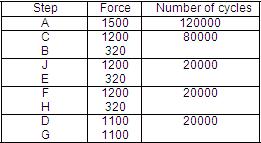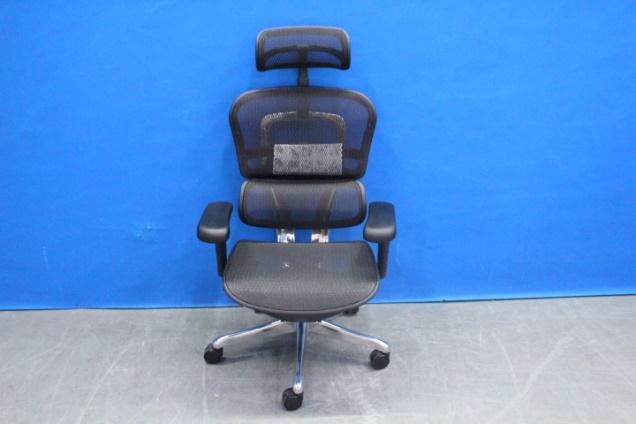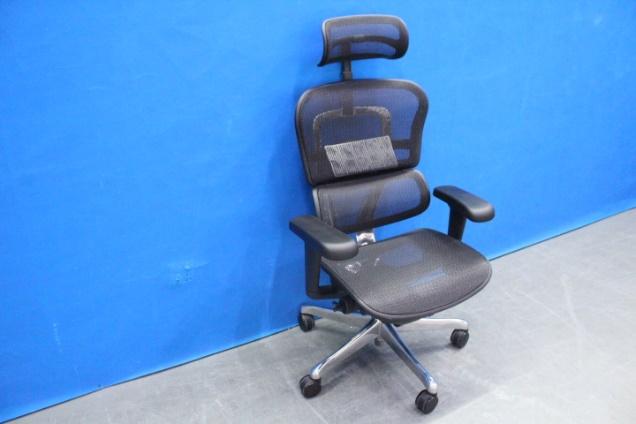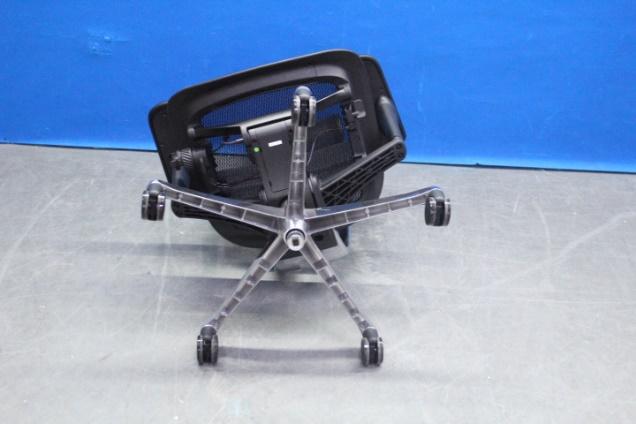
Test Report No.SDHL2310017715FT
COMFORT
Date: Dec 11, 2023
OFFICE FURNITURE CO., LTD GUANGDONG ROOM 1901, NO. 6 XINGSHA ROAD, NANSHA STREET, NANSHA DISTRICT, GUANGZHOU
Sample Description : ERGOHUMAN ULTRA OFFICE CHAIR
Style No. : ERGOHUMAN ULTRA
Item No. : EHU
Client Reference Information : Item No.: G-EHU
As above test item and its relevant information regarding to the submission are provided and confirmed by the applicant. SGS is not liable to either the test item or its relevant information, in terms of the accuracy, suitability, reliability or/and integrity accordingly.
Sample Receiving Date : Oct 09, 2023
Sample Resubmission Date : Nov 24, 2023
Test Performing Date : Oct 09, 2023 to Dec 01, 2023
Test Performed : Selected test(s) as requested by applicant
Test Result Summary
No.
Test(s) Requested
Result(s) Comments
1 EN 1335-2:2018, excluding information for use PASS / For further details, please refer to the following page(s)
Signed for and on behalf of SGS-CSTC Standards Technical Services Co., Ltd. Shunde Branch

Marco Leung
Authorized Signatory



Test Conducted:
TESTS AND RESULTS
Date: Dec 11, 2023
EN 1335-2:2018 Office furniture - Office work chair - Part 2: Safety requirements, excluding information for use.
No. of Sample:
1 piece (Sample #1). For more sample information and pictures, please refer to the following page.
Test and Requirements
4 Safety requirements
4.1 General
The chair shall be so designed as to minimise the risk of injury to the user.
All parts of the chair with which the user comes into contact during intended use, shall be so designed that physical injury and damage to property are avoided. These requirements are fulfilled when:
a)the edges of the seat, back rest and arm rests which are in contact with the user when sitting in the chair are rounded with minimum 2 mm radius;
b)the edges of handles are rounded or chamfered in the direction of the force applied;
c)all other edges and corners are free from burrs and rounded or chamfered;
d)the ends of accessible hollow components are closed or capped.
Movable and adjustable parts shall be designed so that injuries and inadvertent operation are avoided.
It shall be possible to operate the adjusting devices from sitting position in the chair. It shall not be possible for any load bearing part of the chair to come loose unintentionally.
4.2 Shear and squeeze points
4.2.1 Shear and squeeze points under influence of powered mechanisms
There shall be no accessible shear and squeeze points created by parts of the chair operated by powered mechanisms, i.e. springs, gas lifts and motorized systems.
4.2.2 Shear and squeeze points during use
There shall be no accessible shear and squeeze points created by loads applied during normal use.
Shear and squeeze points are not acceptable if there is a risk of injury created by the weight of the user during normal movements and actions, e.g. manipulating levers and crank handles.
4.3 Sequence of testing
All applicable tests shall be carried out on the same sample.
Test Results
The chair shall be tested for stability according to EN 1022:2018, 7.3 and in the order of Table 1. The chair shall be tested for strength and durability according to EN 1728:2012, Clause 7 and in the order of Table 2.
With the exception of the armrest downward static load test – central test, which shall be performed before and after the stability test according to Table 1, the chair shall be tested for stability after the strength and durability tests according to Table 2.
4.4 Stability tests and requirements
When tested according to Table 1, the seating shall not overturn.


Test and Requirements
EN 1022: 2018, 7.3.3 Corner stability test
Date: Dec 11, 2023
This test is only applicable on seating where it is possible to apply the stability loading pad at the specified position. Where features such as arms prevent the loading pad from being applied at the specified position, the test is not applicable.
Position the seating on the floor surface with two adjacent supporting points on the front, or base restrained by stops.
The loading point shall be defined as the point 60 mm from the edge of the load bearing structure on a line that passes through the seat loading point and the intersection of lines parallel to the transverse and median planes, projected from the most forward point of the load bearing structure and the side edges of the load bearing structure of the seat at the widest point on the seat at, or in front of, the transverse plane.
For seating with a single seat apply a force of 300 N vertically by means of the loading pad acting at the loading point X. For seating with multiple seats apply a force of 300 N at the loading point X on one outside seating position.
EN 1022: 2018, 7.3.1 Forwards overbalancing, all seating
Position the seating on the floor surface with two adjacent supporting points on the front or base restrained by stops.
Apply a force of 600 N vertically (for multiple sitting places to a maximum of 2 places, simultaneously) by means of the loading pad acting at those points 60 mm behind the front edge of the load bearing structure most likely to result in overturning.
At each loaded position apply a force of 20 N for at least 5 s horizontally outwards along a horizontal line extended forward from the point where the base of the loading pad meets the upper surface of the seat.
For items of seating with a leg rest attached to the structure of the item, and where the leg rest is designed to support the weight of the user, the test procedure shall be repeated with the leg rest fully extended and the force of 600 N vertically by means of the loading pad acting at the point on the centre line of the leg rest 60 mm behind the front edge of the load bearing structure.
For items of seating with a leg rest not designed to support the weight of the user the test is not applicable to the leg rest.
EN 1022: 2018, 7.3.2 Forwards overturning for seating with footrest
For seating with foot rests of tubular construction, or where the foot rest depth is less than 120 mm, repeat the procedure in 7.3.1 applying the vertical force of 1100 N for swivelling seats and 600 N for all other seating respectively at the most onerous point along the centre line of the tube, or the middle of the foot rest surface, by any suitable means.
Test Results
For all other seating with foot rests apply the vertical force of 600 N at the most onerous point 60 mm from the edge of the foot rest by means of the local loading pad. For foot rests apply a force of 20 N horizontally outwards along a horizontal line extended forward from the point where the base of the loading pad meets the upper surface of the foot rest. N/A


Test and Requirements
Date: Dec 11, 2023
EN 1022: 2018, 7.3.4 Sideways overbalancing, all seating without arms
This test is applicable to all seating where the top edge of the seat on the transverse plane is 50 mm or less above the height of the loaded seat loading point. The transverse plane shall pass through the seat loading point.
Position the seating on the floor surface with two adjacent supporting points on one side, or base restrained by stops.
Apply a force of 600 N vertically by means of the loading pad at a point 60 mm behind the edge of the load bearing structure on the side nearest the stopped feet and on the transverse plane of the seat.
In the transverse plane, apply a sideways force of 20 N horizontally outwards along a line from the point where the base of the loading pad meets the upper surface of the seat.
EN 1022: 2018, 7.3.5 Sideways overturning, all other seating
7.3.5.1 General
This test is applicable to all seating with arms, or where the top edge of the seat on the transverse plane is more than 50 mm above the height of the seat loading point (A).
7.3.5.2 Seating with arm rests
Position the seating on the floor surface with two adjacent supporting points on one side, or base restrained by stops.
Apply a force of 250 N vertically by means of any suitable device, at a point 100 mm to the side of the fore and aft centre line of the seat which is nearest the stopped feet and on the transverse plane.
Apply a force of 350 N vertically by any suitable device, at a position on the centre line of the arm up to a maximum 40 mm inwards from the outside edge of the arm structure at the intersection of the arm rest and the transverse plane, but not less than 40 mm from the front or rear edge of the arm structure.
If the transverse plane does not intersect with the arm rest, apply the force of 350 N 40 mm from the point at the front or rear of the arm rest structure that is nearest the transverse plane.
Apply a horizontal force of 20 N outwards, and perpendicular to the line joining the stopped feet, for at least 5s, at the upper surface of the seat or arm rest in line with the vertical force of 350 N and on the side with stopped feet.
Test Results


Test and Requirements
Date: Dec 11, 2023
EN 1022: 2018, 7.3.6 Rearwards overturning all seating with back rests
The test is not applicable to seating that has adjustable back rest inclination that cannot be locked in position.
For seating that has an adjustable back rest inclination that can be locked in position, it shall be locked in the most upright position. When an independent lumbar adjustment is fitted it shall be set in the most adverse configuration.
Position the seating on the floor surface with the rear legs, two adjacent supporting points on the back, or base restrained by stops.
Apply a vertical force of 600N to the seat by means of the loading pad at the seat loading point (A).
Apply the force F2 horizontally in a rearward direction to the back of the seating at the back loading point, B, or at the top edge of the back rest, whichever is the lower. When the seating has more than one sitting place, carry out the procedure on two most adverse sitting places simultaneously.
If the back rest pad is pivoting around a horizontal axis above the height of the seat and is free to move, the horizontal force shall be applied on the axis. If the back rest is height adjustable, the axis shall be set as close as possible to 300 mm above the seat loading point (A).
EN 1022: 2018, 7.4.2 Tilting chairs
The test method applies to all values of θ ≥ 10° and values of γ between 90° and 170°. If the seating has a locking system it shall be disabled. Load the seat with the 13 loading discs so that the discs are firmly settled against the back rest. If the height of the stack of discs exceeds the height of the back rest, or if support is needed, prevent the discs from sliding off by the use of the support.
4.5 Structural safety requirements
The structural safety requirements are met when the requirements according to 5.2 are fulfilled. 5.2 Requirements
Test Results
The strength and durability requirements are fulfilled when, after testing in accordance with Table 2: a)there are no fractures of any member, joint or component; b)there is no loosening of joints intended to be rigid; and c)the chair fulfils its functions after removal of the test loads.
EN 1728: 2012, 7.3 Combined seat and back static load test
Prevent the chair from moving rearwards by placing stops behind two adjacent supporting points at the rear of the chair.
Chairs with a locking device(s) for seat and/or back rest angle movements shall be tested first with the device(s) locked for half of the cycles and then with the device(s) unlocked for the other half of the cycles. For the first half of the cycles the back rest shall be in the upright position.
Apply a vertical force of 1600 N through the seat loading pad at point A. Keep the seat loaded and apply a force of 560 N through the centre of the back loading pad at point B. When fully loaded the force shall act at (90 ± 10)° to the back rest plane. If the chair tends to overturn, reduce the back rest force and report the actual force. Remove the back force and then the seat force. Repeat the test for 10 cycles. PASS
EN 1728: 2012, 7.4 Seat front edge static load test
Position the smaller seat loading pad at loading point F or J. Apply a vertical downward force of 1600 N for 10 cycles through the centre of the loading pad. PASS







